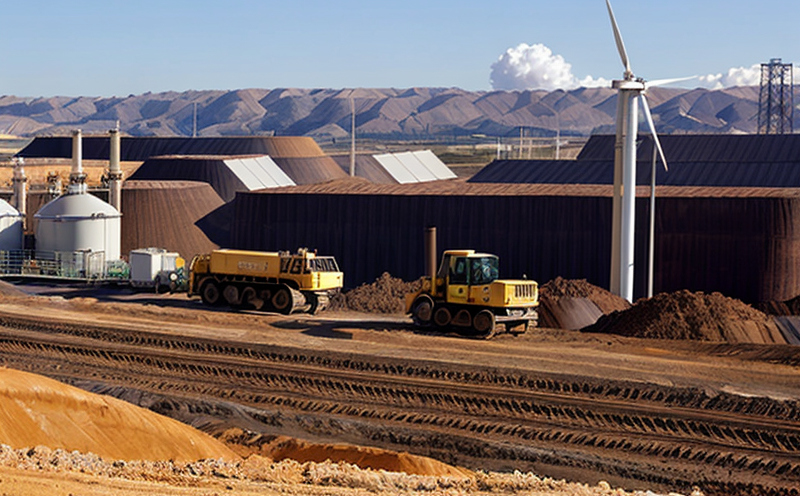ASTM E2928 Water Footprint Assessment in Mining Processes Testing
The ASTM E2928 standard provides a framework for quantifying and assessing the water footprint of mining processes. This assessment is critical for understanding the environmental impact of water use within the mining sector, which often involves large-scale operations with significant water consumption.
Mining processes are inherently resource-intensive, especially when it comes to water usage. Water is utilized in various stages, including exploration, extraction, processing, and waste management. The water footprint assessment helps mine operators identify areas where water use can be optimized or reduced, thereby contributing positively to environmental sustainability.
The ASTM E2928 standard outlines a methodology for calculating the direct and indirect water consumption associated with mining activities. Direct water use includes that which is consumed during production processes, while indirect water use encompasses the water required to produce inputs such as electricity, chemicals, and fuels used in mining operations. By applying this standard, mines can better understand their total water footprint and work towards more sustainable practices.
The assessment process begins with identifying all sources of water consumption within a mine’s operation. This includes both on-site and off-site water use. Once identified, the next step is to categorize these uses into direct and indirect components. Direct water use can be readily quantified using standard monitoring equipment, whereas indirect water use may require more complex calculations involving supply chain analysis.
The ASTM E2928 framework also emphasizes the importance of lifecycle thinking in evaluating water footprints. This approach considers not only the immediate impacts but also those that occur throughout the entire lifecycle of a product or service derived from mining activities. For instance, the water used to extract raw materials could be indirectly impacting communities downstream if it depletes local water supplies.
One of the key aspects of ASTM E2928 is its focus on stakeholder engagement and communication. Effective collaboration between mine operators, regulatory bodies, local communities, and environmental organizations is essential for implementing successful water footprint assessments. Stakeholders play a crucial role in providing data and insights that help refine assessment models and ensure accurate representation of actual water usage patterns.
Another important feature of ASTM E2928 is its flexibility. The standard allows for adjustments based on specific mine conditions, ensuring applicability across diverse operational environments. This adaptability makes it possible to tailor assessments to meet the unique needs of individual mines while adhering to broader industry standards.
| Applied Standards |
|---|
| ASTM E2928-15: Standard Practice for Quantifying and Assessing Water Footprint in Mining Processes |
In summary, the ASTM E2928 standard offers a robust platform for conducting thorough water footprint assessments within mining processes. It enables operators to gain valuable insights into their current practices and explore opportunities for improvement, ultimately fostering greater environmental responsibility.
Applied Standards
ASTM E2928-15 is the primary standard used in conducting water footprint assessments according to this service. Below are some key provisions outlined in the document:
- Identification of direct and indirect water consumption within mining processes.
- Evaluation of lifecycle impacts associated with water usage throughout various stages of operation.
- Inclusion of stakeholder perspectives in assessment methodologies.
The standard ensures consistency and reliability across different mines by providing clear guidelines on how to measure and report water footprints accurately. Compliance with ASTM E2928 helps organizations demonstrate their commitment to sustainable practices, enhancing credibility among stakeholders.
Industry Applications
- Evaluating the environmental impact of mining activities.
- Identifying opportunities for reducing water consumption and improving efficiency.
- Supporting regulatory compliance requirements related to water usage in mining operations.
- Promoting transparency regarding water use within the supply chain.
The application of ASTM E2928 extends beyond individual mines; it also supports broader industry efforts aimed at reducing overall water consumption. By adopting this standard, companies can contribute positively to global sustainability goals while maintaining operational excellence.
Environmental and Sustainability Contributions
Water footprint assessment using ASTM E2928 plays a vital role in promoting environmental stewardship within the mining sector. Here are several ways it contributes:
- Reduction of Ecological Footprint: By quantifying water usage, mines can pinpoint areas where they have the greatest impact on ecosystems and take steps to minimize these effects.
- Enhanced Efficiency: Understanding one's water footprint allows operators to identify inefficiencies in their processes and implement strategies for improvement.
- Informed Decision-Making: The insights gained from assessments enable informed decisions about future investments aimed at reducing environmental impacts.
- Stakeholder Engagement: Collaboration with stakeholders fosters trust and mutual understanding, leading to more effective implementation of sustainable practices.
Beyond these immediate benefits, long-term adoption of ASTM E2928 contributes significantly to global sustainability. It encourages continuous improvement in resource management across the industry, supporting broader environmental goals set by governments and international bodies.





